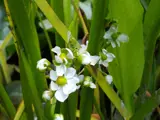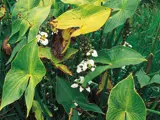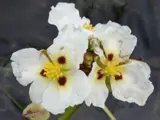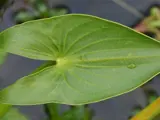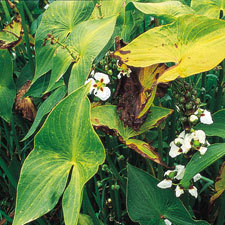 Sagittaria
Sagittaria
Common name: Sagittaria (Also known as Arrowhead)
Botanical name: Sagittaria platyphylla/ Sagittaria montevidensis
Management programme: Eradication
Originates from North America and was introduced to New Zealand as an ornamental pond and aquarium plant. Sagittaria is also known as Arrowhead because of its arrow-shaped leaves.
Why is it a pest?
- Sagittaria can choke waterways, clog irrigation systems, encourage flooding, displace native plants and animals, and degrade fishing, swimming and other recreation opportunities.
- Very difficult to fully control due to the ability of the plant to regenerate from fragments and the extensive rhizome system.
Where is it found?
- Sagittaria can be found in waterways and water margins, storm water and ornamental ponds. Risk areas include static or slow moving fresh water.
- Sagittaria is spread by water dispersed seed, rhizomes and tubers, and also by deliberate planting.
- It is important to ensure machinery hygiene when moving between waterways. Sagittaria platyphylla is easily spread through rhizomes and root fragments.
- There are three known locations in Tauranga and two in Whakatāne.
What does it look like?
- Sagittaria platyphylla leaves are lance shaped above the water and strap shaped below the water.
- It has white/pink flowers from October to March which are produced on spikes and sit at the same level as the emerging leaves.
- Seeds are present in autumn.
- Sagittaria montevidensis has large arrow-shaped leaves on stalks that stand up to 1m above the water.
- White, three-petalled flowers with a purple blotch at the base seen from November to March.
- Sagittaria montevidensis does not produce creeping rhizomes or tubers. It seeds profusely with 100 seeds per plant and each plant maturing quickly being able to produce seed within six months.
What are the rules?
Eradication
Eradication pests are present in the region but are limited in their size or extent of infestation. The eradication of these organisms is a feasible and cost-effective solution. The Bay of Plenty Regional Council is responsible for their control or eradication from the region. Action may be required from landowners or occupiers to support a control operation.
How do you get rid of it?
Please do not attempt to control this plant if you find it. Sagittaria is extremely difficult to control. The Bay of Plenty Regional Council will control it free of charge if it is found in the Bay of Plenty. Please contact the Bay of Plenty Regional Council if you think you have found it.
Images

